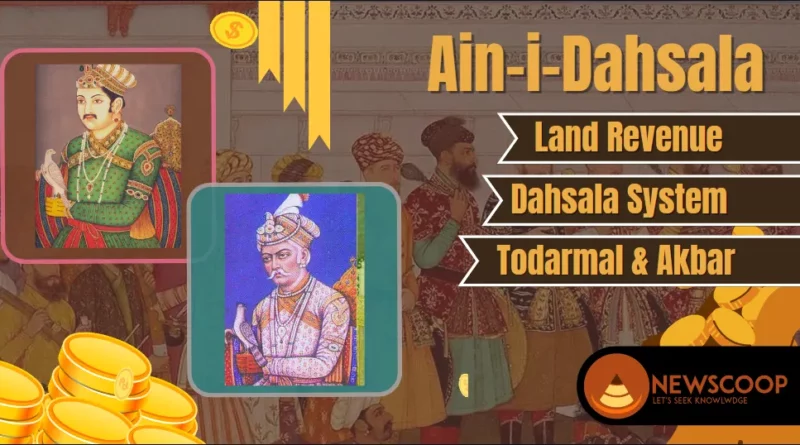Ain-i-Dahsala: Facts of Zabti or Dahsala System for UPSC
Ain-i-Dahsala was a land revenue system under Akbar. In this article, we will try to understand the background and what are the factors that are responsible for the emergence of the Dahsala System. Further, we will also discuss the mechanism & functions of this System.
Ain-i-Dahsala or Dahsala System
Ain-i-Dahsala was a land revenue system of Akbar, and also known as Zabti System or Dahsala System as it was the evolution of Sher Shah Suri’s Zabti System. Further, it was introduced in 1579 by Raja Todar Mal, who was the finance minister of Akbar.
Overview:
- Initially, the Dahsala System was applied to Khalisa land which was directly administered by the emperor. Later on, it was extended to Zagir land as well.
- Earlier, “Bigha” was used for the measurement of land, which was equal to 60*60 yards and was considered the standard unit of area.
- But, in the time of Akbar, the new system Gaj-i-Ilahi was introduced, in which the dimensions were replaced with 41 digits, whose length was 33 inches.
- Regularity along with the productivity of the cultivation was taken into consideration in order to carry out the land revenue of a particular area.
- The Dahsala System was the evolution of the Zabt System, which was introduced by Sher Shah Suri. Further, Zabti System prevailed from Lahore to Allahabad, especially in the provinces of Malwa along with Gujarat.
- The evolution that took place further, is also known as the Dahsala System or 10-year System.
- After Akbar, Shah Jahan implemented this system in the Deccan region as well. Moreover, the name of the man who implemented it was Murshid Quli Khan.
- In this system, 1/3rd of the average produce of 10 years was fixed as the share of the state which was called “Mal” and the rest 2/3rd share was left for cultivators which were called “Kharaj”.
Background of Dahsala System
- The Dahsala system represents the culmination of a series of land revenue experiments of Akbar. Akbar wanted a land revenue system that would stabilize the state revenue.
- After taking command of state affairs in 1562, Akbar appointed a number of Wazirs to reform the revenue system and improve the financial condition of the state.
- Initially, he appointed Asaf Khan, but he failed in this. After that, Akbar appointed Ahmad Khan. Further, Ahmad Shah took a number of steps to reduce state expenditure
- In 1564, Muzaffar Khan was appointed as the head of the financial department and Todar Mal was assigned to assign him. They both took various steps to improve the financial condition of the state.
- In 1574, they did the Karori experiment, in which Khalisa land was divided into a number of revenue circles in such a way that each circle generated a revenue of 1 crore Daam.
Also Read: Mansabdari System of Akbar
Essential Features
- It was based on the survey and Measurement, and it was similar to the Zabti System of Sher Shah Suri.
- Moreover, it had elements of the Ryotwari System.
- It was based on a scientific and rational basis.
- Further, It also had provisions for emergency times like floods, drought, war, etc.
- There was no need to calculate the yield every year, standard yield was fixed.
- Immediately after sowing the seeds, both state & peasants know about the amount of land revenue.
- So, both could plan the income and tax in advance.
- This system was progressive in nature because peasants were encouraged to bring new land under cultivation.
- The Dahsala System encouraged peasants to produce more, as they were required to pay only a fixed amount of land revenue.
Mechanism of Ain-i-Dahsala
In this system, the land was divided into four categories on the basis of the frequency of cultivation:
- Polaj (cultivated every year)
- Parauti (Left fellow for 1 to 2 years)
- Chhachhar (Left fellow for 3 to 4 years)
- Banjar (Left fellow for more than 5 years)
If a farmer used to cultivate Parauti, Chhachhar, or Banjar land, then some advantages were provided to him. Further, they had to pay land revenue after the completion of 5 years. Due to this, peasants were encouraged to bring wasteland to cultivation.
Rate of Revenue:
- Normally, the rate was 1/3rd.
- In Kashmir, the rate was 50%.
- In Multan & Rajasthan, the rate was 1/4th.
Also Read: Rajput Policy of Akbar
The state allowed peasants to adopt any system of land revenue assessment:
- Nashq System
- Kankut System
- Dahsala System or Ain-i-Dahsala
- Muqta System (Bengal)
So, this is all about the Dahsala or Ain-i-Dahsala System. If this information is useful to you, then please share it with your friends.
Thank You!

